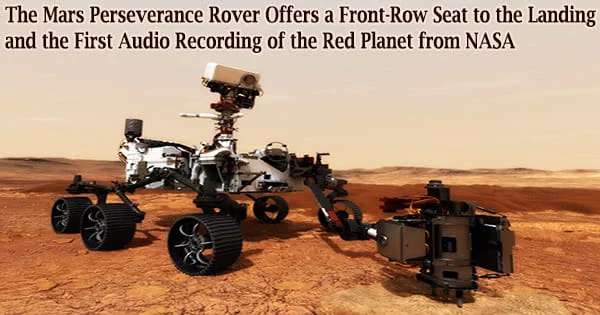As the spacecraft fell, parachuted, and rocketed toward the surface of Mars on Feb. 18, a new video from NASA’s Mars 2020 Perseverance rover records important milestones during the last minutes of its entry, descent, and landing (EDL) on the Red Planet. It also made the first audio recording of sounds from Mars with the use of a microphone on the rover.
The camera system captures the whole descent procedure, including some of the rover’s arduous journey to Mars’ Jezero Crater, beginning with parachute inflation. The footage from the spacecraft’s high-definition cameras begins 7 miles (11 kilometers) above the surface with the supersonic deployment of the largest parachute ever sent to another globe and finishes with the rover’s landing in the crater.
The rover’s microphone did not acquire useable data during the descent, but the commercially available device survived the highly dramatic descend to the surface and recorded sounds from Jezero Crater on Feb. 20. A Martian breeze is audible for a few seconds at 10 seconds into the 60-second clip, as are the mechanical sounds of the rover operating on the surface.
“For those who wonder how you land on Mars or why it is so difficult or how cool it would be to do so you need to look no further,” said acting NASA Administrator Steve Jurczyk.
“Perseverance is just getting started, and already has provided some of the most iconic visuals in space exploration history. It reinforces the remarkable level of engineering and precision that is required to build and fly a vehicle to the Red Planet.”
The first panorama of the rover’s landing site, captured by the two Navigation Cameras on its mast, was also released on Monday. The six-wheeled robotic astrobiologist, the agency’s fifth rover to land on Mars, is currently receiving a thorough inspection of all of its systems and instruments.
We know the public is fascinated with Mars exploration, so we added the EDL Cam microphone to the vehicle because we hoped it could enhance the experience, especially for visually-impaired space fans, and engage and inspire people around the world.
Dave Gruel
“This video of Perseverance’s descent is the closest you can get to landing on Mars without putting on a pressure suit,” said Thomas Zurbuchen, NASA associate administrator for science. “It should become mandatory viewing for young women and men who not only want to explore other worlds and build the spacecraft that will take them there, but also want to be part of the diverse teams achieving all the audacious goals in our future.”
About 230 seconds after the spacecraft hit the Red Planet’s upper atmosphere at 12,500 mph (20,100 kph), the world’s most personal image of a Mars landing began. The camera lens is still covered within the parachute compartment when the video starts.
The spacecraft’s parachute deploys in less than a second, transforming from a compressed 18-by-26-inch (46-by-66-centimeter) nylon, Technora, and Kevlar cylinder into a fully inflated 70.5-foot-wide (21.5-meter-wide) canopy, the largest ever deployed to Mars. The parachute’s tens of thousands of pounds of force generated in such a short time puts a strain on both the parachute and the vehicle.
“Now we finally have a front-row view to what we call ‘the seven minutes of terror’ while landing on Mars,” said Michael Watkins, director of NASA’s Jet Propulsion Laboratory in Southern California, which manages the mission for the agency. “From the explosive opening of the parachute to the landing rockets’ plume sending dust and debris flying at touchdown, it’s absolutely awe-inspiring.”
The heat shield that protected Perseverance from blistering temperatures during its entry into the Martian atmosphere is also shown disintegrating in the video. As the fall stage, with Perseverance attached, swings from the rear shell and parachute, the downward view from the rover sways gently like a pendulum.
The rover’s free-flying “jetpack,” which decelerates using rocket engines before lowering the rover on cables to the surface, breaks free during the descent stage, its eight thrusters engaging to put distance between it and the now-discarded rear shell and the parachute.
Then, 80 seconds and 7,000 feet (2,130 meters) later, the cameras capture the descent stage performing the sky crane maneuver over the landing site the plume of its rocket engines kicking up dust and small rocks that have likely been in place for billions of years.
“We put the EDL camera system onto the spacecraft not only for the opportunity to gain a better understanding of our spacecraft’s performance during entry, descent, and landing but also because we wanted to take the public along for the ride of a lifetime landing on the surface of Mars,” said Dave Gruel, lead engineer for Mars 2020 Perseverance’s EDL camera and microphone subsystem at JPL.
“We know the public is fascinated with Mars exploration, so we added the EDL Cam microphone to the vehicle because we hoped it could enhance the experience, especially for visually-impaired space fans, and engage and inspire people around the world.”
At 1.61 mph (2.6 kph), Perseverance’s aluminum wheels make contact with the surface, and pyrotechnically fired blades break the wires attaching it to the still-hovering descent stage. In the preplanned flyaway move, the descent stage climbs and accelerates away.
“If this were an old Western movie, I’d say the descent stage was our hero riding slowly into the setting Sun, but the heroes are actually back here on Earth,” said Matt Wallace, Mars 2020 Perseverance deputy project manager at JPL. “I’ve been waiting 25 years for the opportunity to see a spacecraft land on Mars. It was worth the wait. Being able to share this with the world is a great moment for our team.”
Five commercial off-the-shelf cameras collected the images mounted on three separate spaceship components. Two cameras captured the parachute inflating on the rear shell, which encased the rover on its voyage.
Two cameras on the rover chassis supplied both upward and downward perspectives, while one on the descent stage provided a downward view including the top of the rover. Perseverance’s systems and immediate surroundings are still being inspected by the rover team.
The team will test five of the rover’s seven instruments on Monday, as well as capture the first weather measurements with the Mars Environmental Dynamics Analyzer. A 360-degree panorama of Jezero captured by the Mastcam-Z should be beamed down in the next days, offering the greatest resolution view of the road ahead.
More About the Mission
Astrobiology, especially the hunt for traces of ancient microbial life, is a major goal of Perseverance’s mission on Mars. The rover will study the planet’s geology and climate history, lay the route for human exploration of Mars, and be the first mission to gather and cache Martian rock and regolith.
Following NASA missions, in collaboration with the European Space Agency (ESA), spacecraft would be sent to Mars to collect these sealed samples from the surface and return them to Earth for further investigation.
The Mars 2020 Perseverance mission is part of NASA’s Moon to Mars exploration strategy, which includes Artemis lunar missions to help prepare for human exploration of Mars. JPL, which is managed for NASA by Caltech in Pasadena, California, built and manages operations of the Perseverance rover.
















